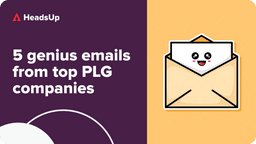The best SaaS companies out there are communicating with their users in hyper-personalized ways.
In this post I’ll show you a few examples of this.
But first, what do I mean?
Imagine you are have millions of users in your product. Most of them are self-serve and have never spoken to sales. At any one point in time, users can be found all over the journey:
- Some users signed up but haven’t really used the product
- Some users are going through onboarding
- Some users are stuck in their usage because they are confused about how to make use of a few advanced features
- Some users are super engaged and nearing the limit of the free plan
These are just a few examples – for complex products you could easily segment users into hundreds of groups, especially if you layer on other criteria like job title or size of company.
Sophisticated PLG go-to-market teams are able to leverage product usage data, and other customer data, and engage with each segment of users at-scale.
Here are some examples Iwe gathered after looking at many emails these PLG companies send out to users.
5 ways top PLG companies personalize user engagement with data
1. Activation
Notion identifies users who have signed up but yet to do much with the product. It then suggests a few actions – setting up workflows, adding teammates – and suggests several ways the onboarding team could help with activating the user – content, answering questions, receiving feedback.
Here is an excerpt from an email Notion sends to some new users:
Looking at usage data, we identified ‘dead ends’ states that users often got stuck in. These are common situations where users don’t see much content within the product and are confused about how to get additional value. We would experiment with product changes and also provide in-app contextual prompts to unblock these users.
– Peter Soung, Co-founder of Sprout Social
2. Encouraging usage and preventing churn
Linear and Zapier look out for instances of low usage and reaches out to these users. This helps to 1) collect feedback 2) increase user engagement to pave the way for expansion 3) pro-actively mitigate churn.
Zapier’s email is part of a sequence:
- They suggest templates to get users started, rescuing new users from dealing with a ‘blank slate’
- They follow up with an email with specific examples of use cases (e.g., Connect your Slack and Trello accounts to automatically create a Trello card for every Slack message you star) with a link to implementing that use case.
- Finally, a human onboarding specialist reaches out. You are invited to tell them exactly what apps you wish to connect, and they can help you with implementing it.
3. Free-to-paid conversion
Dropbox, and other SaaS companies like Amplitude, monitor users to find ones that are about to hit a usage limit or look like they are a good fit for a gated feature.
They then email them with an offer to upgrade before the limit is hit. Sometimes, a discount is offered to prompt an early upgrade.
4. Upsell and 5. Cross-sell
HubSpot has some of the most sophisticated PLG email campaigns. They target existing users and even paid customers and find good triggers to start a conversation about upsell or cross-sell, based on product usage.
Here’s what’s remarkable about HubSpot’s approach:
- They look at usage of individual features. Most PLG messaging is still at the product level (e.g., you are using our product a lot, would you like to upgrade?). Based on features you use, HubSpot brings up complementary features or products that are only available with an upgrade.
- Their content is bespoke. When trying to sell me on a feature only available in the next tier, they attached a video demo of that specific feature. Their email campaigns are able to swap in bespoke content at the level of individual features.
- They are able to map users across accounts. If one user takes an action, HubSpot knows to reach out to that user’s teammates with a talk track mentioning their colleague.
HubSpot’s upsell email:
Hubspot’s cross-sell email:
In summary – there’s a ton of opportunity to use all the data you are collecting from your users. Great PLG companies use that data to be incredibly targeted in their outreach, such that even communication at-scale can be highly effective.
With such a system, GTM teams can move users rapidly from sign up to activation to conversion and expansion.
It’s also what we are working hard at building at HeadsUp, so you can have access to this superpower even if you’re not Hubspot. If you are interested in finding out more, just say hi!


